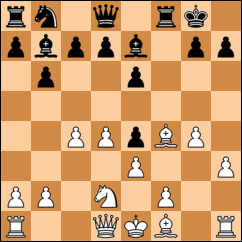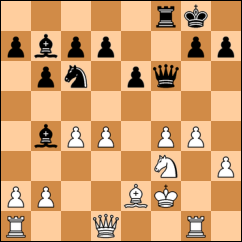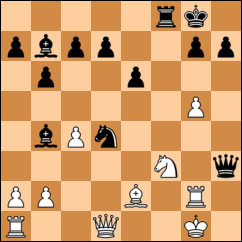Thursday 5 November 2015
White: K. Nevols - Black: S. Milford (145)
1. d4 e6
2. c4 f5
The Dutch defence. The idea of the Dutch is simply to attack on the kingside. I've not come across it before and have never thought much of it. The space around the king just does not look quite right. However, there is the issue that I do not know much about it. I recall Korchnoi having good results by playing an h3 and g4 system. For now, I think just sensible development is the order of the day.
3. Nc3 Nf6
4. Nf3 Be7
5. Bf4
I discovered afterwards that this results in an opening similar to the London system where Black is advised to develop with b6 and Bb7 - as we see here.
5. ... O-O
6. e3 b6
Now I must ask myself the question - what am I going to do? Korchnoi's h3 and g4 kept arriving in my head, aiming to put his kingside under pressure while his queenside still develops. I should though continue with simple development - either Be2 or Bd3.
7. h3?! Bb7
8. g4?
The natural follow up to the h3 idea. The idea is simple - 8. ... fxg4 9. hxg4 Nxg4 10.Rg1 Nf6 11. Bh6 Rf7 12. Ne5. Very basic admittedly. If he does not take the g-pawn then I planned to play g5.
8. ... Ne4!
A much better move and setting up a trap. Here I should play Bd3.
9. Nxe4? fxe4
10. Nd2

My plan was now to round up the pawn with Bg2. I was expecting 10. ... d5 but as he was thinking, I suddenly saw ...
10. .... Rxf4!!
A brilliant sacrifice, but perhaps obvious to Dutch players. I had opened his f-file for him and he now has a devastating central attack.
11. exf4 e3
12. Nf3 Bb4+!
13. Ke2 exf2
14. Kxf2 Qf6
So although he is the exchange down, he has huge compensation in the form of two penetrating bishops, an active queen, and my open king. My knight is pinned, the f4 pawn is under attack, his knight and rook will soon be on the way. Basically it did not look promising.
(The computer recommends 15. d5!? to block the bishop. After 15. .. Qxb2+ then 16. Kg3 or 15. ... Qxf4 16. Qb3. I can't say this looks comfortable however).
15. Be2
I decided to return one pawn to break the pin and get some sort of order going. If 15. Kg3 then Bd6 16. Qd2 g5! I now have 29 minutes left for 20 moves.
15. ... Nc6!
Choosing activity over recouping a pawn. He has 34 minutes left for 20 moves although this is slightly misleading as he was 15 minutes late due to train problems.
16. Rg1
Moving off the diagonal and seeing a way of lateral defence along the fourth rank. But maybe 16. a3 or 16. d5 would have been a better move.
16. ... Rf8

17. g5
It is hard to give White advice - maybe the game is lost after ten moves. The black squares around my king cannot be defended. This is a lone punt but based on an oversight. Again 17. a3 should be considered.
17. ... Qxf4
18. Rg4 Qh2+
I had overlooked this was possible. Now my rook gets back on the diagonal that it was so keen to leave.
19. Rg2 Qxh3
20. Kg1 Nxd4!

In this position, which will win more material, I resigned. The only path from here is 21. Qxd4 Bc5 22. Qxc5 bxc5 23. Rf1. Black has a queen and three pawns for a rook and knight. He had said that he thought I would try to put together some sort of fortress and he would aim to exploit the e3 square, and he could advance straight away with e5-e4, swap pieces off and use the extra pawns. It should be an easy win for Black. I could have played on but considering my state of mind, and shortage of time, I decided to throw in the towel.
A devastating defeat.
No comments:
Post a Comment